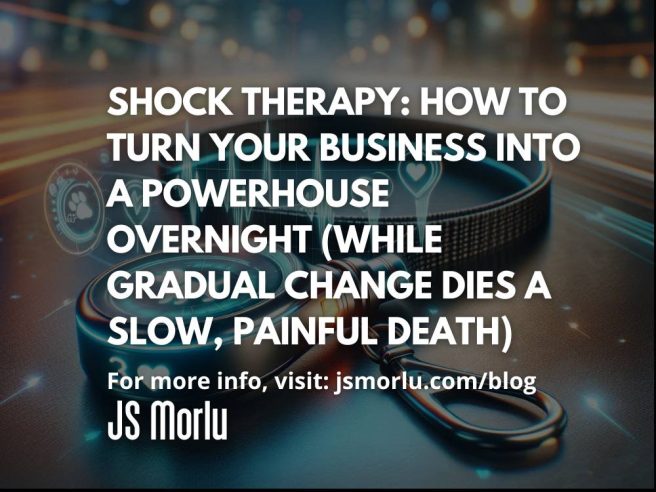By: John S. Morlu II, CPA
Picture this: You’re the CEO of CanineWearables, a company so niche it makes artisanal cheese look mainstream. Your specialty? Smart leashes for dogs. Yes, you heard that right—smart leashes. These aren’t your run-of-the-mill ropes with a metal clip at the end. No, these are technologically advanced marvels equipped with GPS, heart rate monitors, and enough sensors to make a space shuttle blush. In an era where even your dog’s ability to remember its way home seems questionable, your leashes act like high-tech GPS breadcrumbs, ensuring every tail-wagging wanderer returns safely.
But here’s the rub: despite being at the cutting edge of canine technology, your business has been “growing steadily.” In corporate-speak, that translates to “hovering just above the ‘meh’ line on the revenue chart.” It’s the kind of growth that feels less like a triumph and more like a prolonged yawn. Sure, you’ve got a loyal customer base that loves your product, but the financial uptick is more of a gentle incline than the exhilarating rise you’d hoped for. Your accountant—an over-caffeinated, spreadsheet-obsessed character who probably moonlights as a librarian for the Bureau of Boring Businesses—keeps mumbling about “flatlining revenue” and “the limits of incremental growth.” His constant droning about “steady progress” has begun to sound like nails on a chalkboard.
You, on the other hand, are dreaming of grandeur. Enter shock therapy—the business world’s equivalent of an adrenaline shot. You stumbled upon this electrifying concept while doomscrolling on your phone during a particularly dreary lunch break. There it was, a headline that practically jumped off the screen: the incredible saga of Jeffrey Sachs and his audacious economic reforms. Sachs had taken nations from dreary, centrally planned economic quagmires to vibrant, capitalist powerhouses seemingly overnight. Nations that once were mired in bureaucratic mire were now bustling with free-market energy and dynamism. If Sachs could turn entire countries around with shock therapy, surely your dog leash company could use a jolt of that same magic.
The idea of gradual change—a slow, agonizing crawl marked by constant tweaks and year-long strategic plans—had started to grate on you. Who needs another five-year plan when you can dive headfirst into the fast lane? You envisioned ditching the drudgery of incremental improvement for the sheer thrill of shock therapy. With Jeffrey Sachs’ revolutionary zeal burning in your chest and a mischievous twinkle in your eye, you made a daring decision: to transform CanineWearables from a quaint, under-the-radar player into a globe-spanning sensation using nothing but shock therapy.
Forget fine-tuning and gradual growth. You were ready to bypass the slow lane and rocket straight to the big leagues. With shock therapy as your guiding star, your mission was clear: catapult CanineWearables from its current, somewhat unremarkable state into the stratosphere of business success. You envisioned a world where every dog owner—and their state-of-the-art, GPS-enabled leashes—knew your name.
So buckle up, because you’re about to embark on an exhilarating ride where “slow and steady” is thrown out the window, and shock therapy takes the wheel. Prepare for a transformation that promises less of a gentle nudge and more of a full-throttle rocket launch. CanineWearables is about to leap from being a quaint curiosity to a global sensation, and you’re the fearless leader steering this ship into the unknown. Get ready to redefine what’s possible and witness a business metamorphosis that’s as thrilling as a dog chasing its tail—but with a much more impressive payoff.
Chapter 1: The Shock Announcement
“We’re done with this slow, painful growth,” you declared at the Monday morning meeting, your enthusiasm radiating like a solar flare. “We’re going all in on shock therapy.”
The room fell into a stunned silence, punctuated only by the faint whirr of the office coffee machine—perhaps it, too, was processing the shock. Your employees blinked at you as if you’d just suggested replacing their chairs with pogo sticks.
Sarah, the head of R&D, cleared her throat and raised her hand with the hesitant air of someone who had just been invited to the opera by a stranger in a trench coat. “You mean like the economic shock therapy? The one where countries had their economies ripped apart and reassembled like a high-stakes game of Jenga in the ’90s?”
“Bingo!” you said, grinning wider than a Cheshire cat that just found the world’s largest can of tuna. “We’re going to dismantle our entire pricing structure, radically transform our product line, and introduce DogCoin—our very own blockchain-based currency for all future transactions. Think of it as capitalism with a jetpack!”
The team exchanged glances that could only be described as “confused terror,” as if they were trying to decipher a cryptic crossword puzzle written in ancient hieroglyphics. Brad from Marketing, who had been diligently sketching dog illustrations on a notepad, blinked up at you with the bewildered look of someone who had just been told that all their pet puns would be replaced by quantum physics lectures.
“DogCoin?” Brad repeated slowly, as if testing the taste of a particularly strange new flavor of ice cream. “Is this a cryptocurrency or a new breed of dog?”
“Both!” you said with exaggerated flair. “It’s our way of bringing the future to our customers, and it’ll make every dog walker feel like they’re walking with a piece of cutting-edge technology. And don’t worry, the DogCoin wallet comes with a built-in dog treat dispenser for added convenience.”
Janice from Customer Service, who had been staring blankly at her notepad, suddenly perked up. “So, does this mean we’re also changing our dog leashes into some sort of space-age gadget?”
“Absolutely!” you confirmed, as if unveiling the secrets of the universe. “We’re talking GPS, heart rate monitors, and even mood sensors that’ll let you know if your dog is feeling happy, sad, or plotting its next great escape. Imagine a leash that not only tracks your dog’s every move but also provides a detailed emotional analysis. It’s like having a personal canine therapist!”
The room was filled with a mix of stunned silence and barely suppressed laughter. You could practically see the gears turning in their heads as they tried to wrap their minds around this audacious plan. As if the idea of a leash that could read a dog’s mood wasn’t already mind-bending enough, you continued, “And to kick things off, we’re launching a new marketing campaign: ‘Unleash the Future with DogCoin!’ Expect holograms, interactive dog parks, and possibly even a dog-leash dance party. Because if we’re going to shock the world, we might as well do it with style!”
Bob from Finance, who had been furiously tapping away at his calculator like it was a time machine, finally spoke up. “And how exactly are we going to manage this financial whirlwind? Have you seen our budget?”
“I’ve got it all figured out,” you said confidently, waving a hand as if you were conjuring magical solutions out of thin air. “We’ll seek out investors, launch a crowdfunding campaign, and, of course, sell DogCoin directly to our enthusiastic customers. We’re not just changing the game; we’re rewriting the rulebook!”
The room erupted into a cacophony of hushed murmurs, skeptical glances, and a few stifled chuckles. It was clear that the team was still grappling with the sheer scale of the transformation you had just proposed. But you could see the flickers of excitement behind their eyes, the dawning realization that something truly revolutionary was about to take shape.
“Look,” you said, addressing them with the gravitas of someone unveiling the secrets of the cosmos, “this is going to be a wild ride. It might be messy, it might be chaotic, but it’s going to be unforgettable. And I promise you, by the end of this journey, CanineWearables will not just be a company; it’ll be a phenomenon.”
As the meeting wrapped up and your team shuffled out, you couldn’t help but feel a surge of exhilaration. You knew that what you were proposing was nothing short of radical. It was the business equivalent of setting off fireworks in a library—unexpected, a bit risky, and definitely eye-catching. But if you pulled it off, CanineWearables would not only be the go-to name in dog leashes; it would be the name on everyone’s lips, and you’d be the maverick CEO who turned a quirky idea into an industry revolution.
And so, with a heart full of excitement and a head brimming with wild ideas, you prepared for the adventure ahead. The shock therapy had been announced, and the real work—transforming CanineWearables into a juggernaut of innovation—was just beginning. Buckle up, because the ride was about to get bumpy, exhilarating, and, above all, wildly entertaining.
Chapter 2: Dynamic Pricing—And It Actually Works?
The first major shake-up in your shock therapy overhaul was dynamic pricing on your website. Inspired by Jeffrey Sachs’ economic sorcery, you decided to throw the rulebook out the window and let the market—i.e., your quirky customers—determine what they were willing to pay for your high-tech leashes. This wasn’t just a price change; this was pricing roulette. A leash that once cost a steady $150 could now be snagged for as little as $20 or, if luck wasn’t on your side, splurged for a whopping $300, all depending on the time of purchase.
As you prepared to launch this audacious pricing model, Sarah from R&D looked like someone who’d just been handed a ticket to the apocalypse. She was muttering about “market chaos” and “potential customer revolt,” her skepticism palpable. You, however, were riding high on a wave of revolutionary fervor. This was your chance to shake up the dog leash market like a snow globe and see what glittering wonders would fall out.
The day the new pricing model went live was nothing short of electric. Your website was suddenly buzzing with activity, as if the internet itself had decided to take a break from cat videos to check out the latest in canine couture. Customers began flocking to the site, eyes gleaming with the tantalizing prospect of scoring a premium smart leash at a bargain price. The thrill of potentially getting a high-end leash for next to nothing had turned shopping into a full-contact sport.
One customer, Jane from Boise, posted on social media, “Just scored a leash for $25! Feels like I won the lottery, but for my dog!” Meanwhile, Tim from Toronto was less thrilled when he ended up paying $275 for a leash but still commented, “I’ve never felt this much excitement buying a leash before. Kudos for making pet shopping an adrenaline sport!”
Your gamble had not only paid off; it had exceeded expectations. Sales surged by an eye-popping 50% by the end of the week. The dynamic pricing model had turned what was once a steady revenue stream into a rollercoaster of excitement, both for you and your customers. People were actively hunting for those sweet deals, and even those who paid top dollar admitted they’d never had such an adrenaline rush shopping for dog accessories.
Sarah, who had initially been giving you side-eye looks as if you’d declared your intent to swim with sharks in a kiddie pool, was now practically buzzing with new ideas. She had transformed from the department’s resident skeptic to the company’s chief innovator, sketching out concepts for a smart leash with a built-in dog selfie camera. That’s right—a leash that not only tracks your dog’s location but also snaps and uploads selfies of Fido as he prances about, ensuring every moment of his day is shared with his growing fanbase.
Your marketing team, initially puzzled by the concept of pricing roulette, was now drafting campaigns touting “The Thrill of the Deal” and “Every Purchase a Prize.” The website featured a live counter showing the number of deals left at various price points, turning shopping into a high-stakes game show. You even joked about adding a “Buy Now or Forever Hold Your Peace” button for extra drama.
The dynamic pricing model had turned the mundane act of buying a dog leash into a thrilling gamble, transforming your website into the most exciting place on the internet for pet accessories. Customers were not just buying leashes; they were participating in a grand, unpredictable spectacle that made them feel like part of something bigger and more exhilarating.
Your team was abuzz with new energy and ideas, and you could hardly believe the turnaround. You had not only disrupted the dog leash market; you had revitalized your entire company with a jolt of excitement that left everyone eagerly awaiting the next innovation.
And so, with the shock therapy model proving its worth and Sarah now championing cutting-edge ideas, you were ready for the next phase of your grand transformation. The dog leash market was just the beginning—who knew what other traditional business models you’d reinvent next? For now, though, you were riding high on the wave of success, basking in the glory of having turned pricing into a thrilling adventure and your company into a beacon of innovative brilliance.
Chapter 3: DogCoin Goes Live
No shock therapy strategy is truly complete without a radical currency overhaul. And so, following the footsteps of Jeffrey Sachs and his economic alchemy, you decided that CanineWearables needed its own digital currency: DogCoin. Yes, DogCoin. Gone were the days of drab, old dollars and mundane credit cards. You envisioned a brave new world where customers purchased leashes with a blockchain-based currency you controlled—a currency so cutting-edge it might as well come with a dog-friendly AI sidekick.
“DogCoin will revolutionize our customer experience,” you declared during the second week’s strategy meeting, eyes gleaming with the fervor of a revolutionary leader announcing a new regime. “It’s digital, it’s decentralized, and it gives us flexibility with pricing and loyalty rewards. Imagine, no more tedious transactions with conventional money. Instead, we’ll have a currency that’s as innovative as our leashes!”
The room was silent, save for the faint sound of the collective eyebrows of your team lifting in skepticism. Sarah, who had begun to enjoy her role as the department’s resident doubter, squinted at you with the kind of look usually reserved for people who claim to have discovered a perpetual motion machine in their basement. “DogCoin?” she echoed, as if trying to decipher if you were serious or if this was some elaborate prank.
But you were undeterred. You had seen Sachs’ economic reforms transform entire economies with a whirlwind of change, and you were ready to bring that same whirlwind to CanineWearables. To jumpstart DogCoin’s adoption, you launched a series of viral social media campaigns. The pièce de résistance? A hilarious YouTube skit featuring famous dogfluencers—think Instagram-famous poodles and viral Shih Tzus—performing mock “transactions” with DogCoin while donning over-the-top “financial advisor” outfits.
The skit went viral. People loved it, and they started to think of DogCoin not just as a new way to pay but as a fun, quirky addition to their pet-related purchases. The initial adoption was slow, but the buzz had been created. Soon, DogCoin began to catch on like wildfire. Tech-savvy millennials, who previously couldn’t care less about dog leashes, now saw buying a smart leash as a golden opportunity to flex their cryptocurrency prowess. They were treating DogCoin like it was a badge of honor, eagerly showing off their wallets on social media.
And then came the whirlwind. DogCoin’s value began to fluctuate wildly, and not in the way you might expect. Instead of causing chaos, the volatility actually fueled excitement. Customers started trading DogCoin amongst themselves, creating a mini-economy within your own company’s ecosystem. It became a bit like the stock market, but with more fur and fewer spreadsheets. There were even online forums dedicated to predicting the next big DogCoin surge, complete with enthusiastic debates and animated GIFs of dogs in business suits.
Within just one week, DogCoin had increased in value by an astounding 300%. Your smart leashes, once a niche product for tech-savvy dog owners, were now the hottest commodity in the dog-tech world. The media caught wind of the spectacle and jumped on the bandwagon. “How DogCoin Made a Smart Leash Company the Hottest Business of 2024,” read the headline in TechCrunch, complete with a feature photo of your top-selling leash adorned with a “Powered by DogCoin” tag.
Competitors—those conservative businesses that were still trudging through “steady growth” and treating dog leashes like a conventional commodity—were left choking on your dust. They watched in disbelief as your revolutionary approach turned what had once been a quaint niche market into a global sensation.
In your company, the atmosphere had shifted from cautious skepticism to jubilant enthusiasm. The marketing team, initially baffled by the concept of a dog-centric cryptocurrency, was now in full swing, crafting memes and promotional videos celebrating DogCoin’s meteoric rise. The customer service department had even started fielding calls from excited customers eager to know more about how they could use DogCoin for future purchases, and your sales team was busy explaining to dog owners why their leashes were now worth their weight in crypto gold.
Sarah, who had once viewed DogCoin as a whimsical fantasy, was now enthusiastically sketching plans for a DogCoin-exclusive leash model—a product so futuristic it might as well have come with its own AI-powered dog trainer. The team was abuzz with new ideas and innovations, all fueled by the success of your digital currency experiment.
So there you were, at the helm of a company that had gone from a quaint niche player to a major disruptor in the pet industry. The shock therapy had worked, turning a simple dog leash company into a dazzling example of what happens when you throw out the rulebook and embrace the wild, unpredictable world of blockchain and cryptocurrency. And as DogCoin continued to soar, you couldn’t help but bask in the thrill of having created a revolution—one leash and one DogCoin at a time.
Chapter 4: Labor Reforms—Motivation on Steroids
In a move that could only be described as both audacious and uncharted, you decided to tackle the thorny issue of employee compensation with a strategy that could make even the most seasoned CEO break a sweat: complete overhaul. Gone were the days of predictable base salaries. Instead, you introduced a revolutionary new system where employees would be paid entirely based on how much revenue they generated. Yes, that’s right—salary by sales, compensation by contribution. It was a classic shock therapy maneuver, with a twist that would make even Jeffrey Sachs do a double-take.
The announcement of this new policy was met with an almost audible gasp. You could practically hear the collective clicking of LinkedIn tabs as your employees frantically updated their résumés and looked for other job opportunities with the same fervor as a hamster on a caffeine rush. Faces paled, fingers trembled, and a murmur of panic rolled through the office like a low, worried tide. It was clear that your staff was more than a little apprehensive about the new regime.
But you stood firm, channeling your inner economic revolutionary. “This is a meritocracy now,” you declared with the enthusiasm of someone who had just discovered the secret to eternal youth. “You’ll get what you earn. It’s time to put your skills to the test and show us what you’re made of.”
To your surprise—and probably to the surprise of your employees, too—the sky didn’t fall. The mass resignations didn’t materialize. Instead, a remarkable transformation began to unfold. What followed was a workplace renaissance, fueled by a newfound motivation that was less like a gentle nudge and more like a caffeine-infused jolt to the system.
The sales team, once casually pushing leashes with the same effort as a Sunday stroll, now operated like a group of hyper-competitive auctioneers. They took the new dynamic pricing model and DogCoin promotion to heart, pushing harder than ever to make sales and secure those lucrative DogCoin transactions. The call center, previously a haven of quiet phone calls and routine inquiries, was now a bustling hub of activity, with orders flooding in faster than anyone could keep up. Your customer service representatives, who had once coasted through their shifts, turned every mundane inquiry into a golden upsell opportunity. One of them even started a side hustle as a part-time DogCoin guru, offering impromptu advice on cryptocurrency to bewildered customers who’d called in about leash returns.
Sarah, your ever-cautious head of R&D, experienced a career metamorphosis. No longer content to stay within the confines of product development, she threw herself into marketing efforts with the zeal of someone who had just discovered that selling DogCoin could pay her rent. Her innovation wasn’t limited to product features anymore; she was now brainstorming social media campaigns and creating buzzworthy content to drive up DogCoin sales. Her newfound enthusiasm was so infectious that even the office plants seemed to perk up in response.
And then there were the mixed results. Some employees thrived under the new system. They embraced the challenge and reveled in the opportunity to directly reap the rewards of their hard work. They became supercharged versions of themselves, firing on all cylinders and pushing the company to new heights. Others, however, struggled under the pressure. The pressure-cooker environment revealed cracks in their performance that had previously been hidden by the safety net of a steady salary. But even these employees, while struggling, contributed to an overall surge in productivity.
The results were astounding. By the end of the second week, revenue had tripled. Yes, tripled. The office had transformed into a high-octane environment where every employee was driven by the carrot-and-stick dynamic of performance-based pay. The energy was palpable, and the excitement was almost tangible. It was as if the entire office had been supercharged with a shot of adrenaline, and every task, no matter how mundane, was now approached with the fervor of a quest for gold.
Your decision to overhaul compensation had sparked a revolution within CanineWearables. What had once been a comfortable but stagnant workplace had turned into a dynamic powerhouse of innovation and productivity. And as you looked around at your bustling, motivated team, you couldn’t help but feel a sense of satisfaction. The shock therapy had worked, turning what could have been a potential disaster into an exhilarating success.
In the end, you had managed to transform a sleepy little company into a beacon of high-energy performance. The old way of doing things was gone, replaced by a system where meritocracy wasn’t just a buzzword—it was the very foundation of your company’s success. And with productivity soaring, revenue skyrocketing, and your employees motivated beyond their wildest dreams, it was clear that your gamble had paid off. The shock therapy had worked, and CanineWearables was now a shining example of what happens when you throw caution to the wind and embrace a bold new vision.
Chapter 5: Opening the Supply Chain—A Stroke of Genius
Shock therapy isn’t just about currencies and labor. Oh no, it’s about diving headfirst into the deep end of the free market and making it your personal playground. Inspired by Sachs’ bold dismantling of trade barriers and his ability to turn economic flops into global spectacles, you decided it was time to open up CanineWearables‘ supply chain to the wild and unpredictable world of international competition.
Why limit yourself to traditional suppliers when you could source cheaper parts from every corner of the globe? The notion of sticking to your old, reliable suppliers started to feel like a quaint relic of a bygone era. It was time to channel your inner economic daredevil and embrace the chaos of the free market.
Sure, opening up the supply chain involved risks—like when Russia’s economy was swamped with cheap imports that crushed domestic industries and left local businesses floundering like fish out of water. But hey, that was their problem, not yours. You were convinced that this strategy would work wonders for CanineWearables, and you were ready to gamble on it.
So, with the enthusiasm of a kid in a candy store, you embarked on a global sourcing spree. You reached out to suppliers across Asia, Eastern Europe, and parts of South America. It was like creating an international scavenger hunt for the cheapest, quirkiest components you could find. Who cares if some of these suppliers had safety standards that could be generously described as “sketchy” or “highly adventurous”? Your customers didn’t ask too many questions about the origins of their smart leashes—they just wanted them at rock-bottom prices.
And guess what? It worked like a charm. Production costs plummeted by a jaw-dropping 40%. You felt like a wizard of cost reduction, conjuring up savings out of thin air. The entire process was so seamless it was almost as if you had cracked some kind of corporate magic code.
As the price of your smart leashes dropped, customers flocked to your site like bees to honey. They didn’t care that their leashes might have come from a factory with a nonchalant attitude toward quality control. What mattered to them was that they were getting a smart leash for a fraction of the original price. And for you, the lower production costs meant even fatter margins. It was a win-win that felt almost too good to be true.
Soon enough, CanineWearables had built a reputation for being the go-to brand for the best smart leashes at the cheapest prices. Your competitors, those poor souls still clinging to their outdated supply chains, looked on in envy as you reveled in your newfound success. They were left scratching their heads, trying to figure out how you had managed to offer such irresistible prices without apparently sacrificing quality.
In a twist of irony, your innovative approach to global supply chain management had turned you into the market leader in dog leashes. Your competitors were left choking on your dust, and you were basking in the glory of your genius decision.
The best part? No one cared about the behind-the-scenes drama. Customers were thrilled with their bargains, and your margins were soaring. CanineWearables had become the epitome of “cutting-edge” without a single care for conventional wisdom or domestic pride.
So, as you reveled in the fruits of your international supply chain adventure, you couldn’t help but chuckle at the thought of how far you’d come. What started as a small dog leash company had transformed into a global sensation, all thanks to your willingness to embrace shock therapy and go all-in on the free market. And with production costs slashed and sales soaring, you knew one thing for sure: sometimes, the best way to shake things up is to throw caution to the wind and see where it lands. In your case, it landed squarely in the lap of success.
Chapter 6: The Slow Death of Gradual Change
As CanineWearables soared into the stratosphere of business success, your competitors—who clung to the time-honored philosophy of “slow and steady wins the race”—were left scrambling in the dust, their tails between their legs. Companies like PupTrack and DogGoWear had built their brands on the quaint idea of gradual improvement. They were the poster children for incremental change: rolling out small, almost imperceptible updates, tweaking designs with the precision of a watchmaker, and patiently waiting for the market to catch on. They believed in customer loyalty, incremental growth, and, above all, the power of “building trust.”
PupTrack, for example, had spent the last decade perfecting their leashes. Their marketing materials proudly boasted of their “30 years of experience in leash refinement,” a process that involved endless focus groups and minor adjustments to the handle’s ergonomic grip. They thought their slow-and-steady approach would eventually lead them to dominance in the market. Unfortunately, they hadn’t accounted for the fact that while they were meticulously adjusting their leash grips, CanineWearables was unleashing a digital revolution.
DogGoWear, on the other hand, had a similar story. They prided themselves on their “trust-based approach,” which meant that they rolled out new products at a snail’s pace, convinced that patience and loyalty would eventually win the day. They believed that gradually improving their leashes—one tiny innovation at a time—would be enough to maintain customer interest. They even had a “DogGoWear Loyalty Club,” where members received a new leash upgrade every 18 months. How charmingly old-fashioned!
But as CanineWearables roared ahead with its shock therapy strategy, the contrast was stark. Your company had transformed from a niche player into a tech-forward juggernaut within a month. The market had shifted dramatically in your favor, and while PupTrack and DogGoWear were still fiddling with their prototypes and market surveys, you were basking in the glory of blockchain integration and dynamic pricing.
Forbes ran a glowing profile on CanineWearables, dubbing you “The Jeff Bezos of Dog Leashes.” The article praised your audacious approach and highlighted how CanineWearables had revolutionized the pet accessory industry overnight. You shrugged off the praise with your trademark modesty, but inside, you were reveling in the success. Your rise was so meteoric that it made the slow, steady climb of your competitors look like a leisurely stroll through a cemetery.
Meanwhile, your competitors were facing the grim reaper of business failure. PupTrack, unable to keep up with the demand for tech-driven pet accessories, quietly filed for bankruptcy. The once-esteemed company was forced to shut its doors, its leashes becoming little more than a footnote in the history of pet accessories. Their loyal customers were left to mourn the loss of their favorite leash brand, and the market’s shift toward high-tech solutions was just too much for them to handle.
DogGoWear’s fate was even more dramatic. In a desperate bid to stay afloat, they were bought out by a venture capital firm that promptly stripped the company for parts. The once-proud brand was dismantled, its assets sold off, and its name consigned to the annals of “has-been” companies. The firm’s new venture capitalists, who were perhaps more interested in maximizing their return on investment than in preserving the integrity of the brand, seemed to relish the irony of dismantling a company built on the principles of incremental growth.
As your competitors struggled to adapt, you watched with a mix of schadenfreude and satisfaction. The market had spoken, and it was clear that shock therapy was the future. The days of gradual change, with their painstakingly slow progress and measured improvements, were becoming increasingly obsolete. In their place was a new era of rapid transformation, driven by bold decisions and audacious strategies.
Your success had become a case study in how to disrupt an industry and leave traditional competitors in the dust. As CanineWearables continued to innovate and expand, the lessons of shock therapy were clear: in a world that moves at the speed of digital transformation, gradual change was not just slow; it was dead. And as you celebrated your company’s meteoric rise, you knew one thing for certain: in the fast-paced world of business, it’s better to be a shockwave than a slow-motion replay.
Chapter 7: Shock Therapy’s Victory Lap
By the end of the first year, CanineWearables had rocketed from niche obscurity to dazzling household name. In a world that had been shackled by outdated business models and stale innovation, your company had become the epitome of cutting-edge brilliance. Gradual improvement had met its demise, a relic of the past, while your business stood as a lean, mean, capitalist machine, turbocharged by the sheer audacity of shock therapy.
You now occupied a sleek corner office, high above the city skyline, with a panoramic view that made you feel like the ruler of a sprawling empire. Your new digs were a far cry from the humble cubicles where you’d first dreamed of transforming the dog leash industry. From this vantage point, you watched as your company’s name glowed like a beacon of innovation on billboards and tech magazines alike.
The story of how you had embraced shock therapy was now a legend in its own right. Jeffrey Sachs might have transformed entire nations in the ’90s, but you had achieved something just as extraordinary: a complete overhaul of CanineWearables in a matter of months. It wasn’t just about shaking up an industry—it was about setting a new standard. Sachs’ legacy was impressive, but your legacy was electrifying.
Reflecting on the whirlwind of changes—dynamic pricing, DogCoin, a meritocracy of motivation, and a global supply chain—it felt like you had navigated a high-stakes adventure game. You had dodged the pitfalls of gradualism and sprinted straight into the heart of business transformation. Chaos had been your ally, and it had led you to victory.
“Gradual change?” you scoffed, remembering how your competitors had clung to their slow-and-steady routines. To them, gradual change was a comfortable pair of old slippers—predictable and safe but utterly unspectacular. For you, gradual change had been a mere stepping stone to the exhilarating heights of shock therapy. It was like comparing a bicycle ride to a rocket launch.
And the results spoke for themselves. Your competitors, once formidable players in the dog accessory industry, had been left in the dust. PupTrack’s bankruptcy and DogGoWear’s disintegration were stark reminders of what happened when businesses refused to embrace the future. Meanwhile, CanineWearables was setting the pace, redefining what it meant to innovate and thrive in the modern marketplace.
With every press release and headline extolling the virtues of your shock therapy revolution, you couldn’t help but feel a surge of pride. “The Jeff Bezos of Dog Leashes,” Forbes had called you, and while you’d never publicly admit how much you loved that title, you savored every moment of it.
But as you celebrated, a sobering thought drifted through your mind. In today’s high-speed business environment, where competition is fierce and investors’ patience wears thin, gradualism is like setting sail with a leaky boat in a storm. Investors demand quick returns and bankers are only too eager to shy away from companies that don’t deliver instant results. Gradual changes, those painstakingly slow tweaks and iterative improvements, could spell a one-way ticket to the Google Graveyard—a digital purgatory for businesses that failed to keep pace with the relentless march of innovation.
In this fast-paced world, if you’re not delivering concentrated results with urgency, you’re not just lagging behind; you’re becoming invisible. Investors will flee to the next shiny new object, and bankers will turn their backs if they don’t see immediate progress. Gradualism, once considered a safe bet, is now a risky strategy that can leave a company stranded in obscurity while its competitors blaze ahead with bold moves and disruptive strategies.
So here’s to shock therapy, to innovation on steroids, and to the thrill of defying expectations. CanineWearables wasn’t just a company anymore; it was a movement. And you were the fearless leader who had steered it to triumph. As you took one last look at the skyline, you couldn’t help but smile, knowing that the future was not just bright—it was blindingly brilliant. In the fast lane of modern business, shock therapy wasn’t just a strategy; it was a lifeline. And you were leading the charge with a blazing trail of success.
Author: John S. Morlu II, CPA is the CEO and Chief Strategist of JS Morlu, leads a globally recognized public accounting and management consultancy firm. Under his visionary leadership, JS Morlu has become a pioneer in developing cutting-edge technologies across B2B, B2C, P2P, and B2G verticals. The firm’s groundbreaking innovations include AI-powered reconciliation software (ReckSoft.com) and advanced cloud accounting solutions (FinovatePro.com), setting new industry standards for efficiency, accuracy, and technological excellence.
JS Morlu LLC is a top-tier accounting firm based in Woodbridge, Virginia, with a team of highly experienced and qualified CPAs and business advisors. We are dedicated to providing comprehensive accounting, tax, and business advisory services to clients throughout the Washington, D.C. Metro Area and the surrounding regions. With over a decade of experience, we have cultivated a deep understanding of our clients’ needs and aspirations. We recognize that our clients seek more than just value-added accounting services; they seek a trusted partner who can guide them towards achieving their business goals and personal financial well-being.
Talk to us || What our clients says about us








